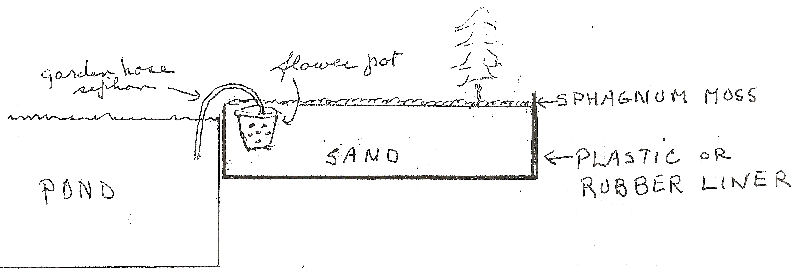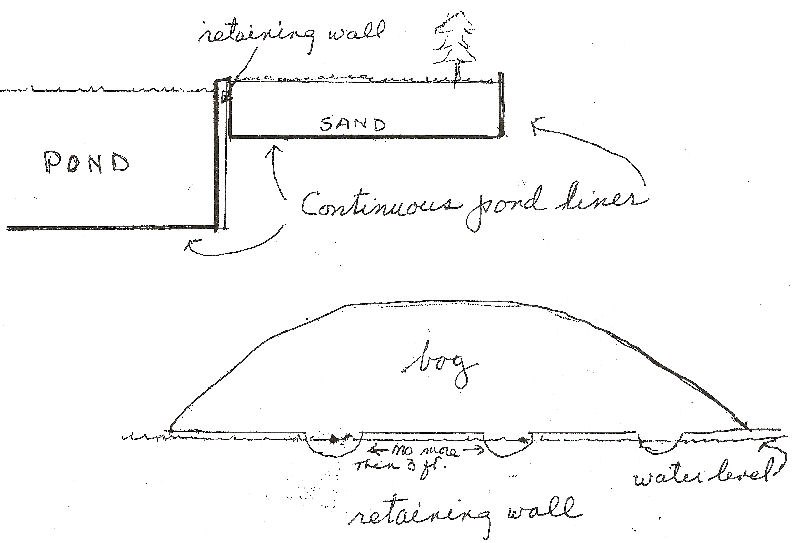Building a Sphagnum Bog Garden
by Roberta and Fred Case
Sphagnum moss makes an ideal substrate in which to grow some of the showy and more difficult bog and swamp plants, especially carnivorous plants and certain native orchids. And sphagnum moss is attractive in itself.
Sphagnum moss requires a constant source of suitable water. Chlorinated or very limey water kills it. However, placing it in a bog next to a pond can solve the water problem. Growing it on neutral or acid sand is a suitable substrate.
LOCATION:
- Full sun, if possible. The sphagnum doesn't need it but many of the showier bog plants do.
- Area should not collect run off from lawn or other areas. You want only the pond water to enter the bog.
- A long and narrow bog garden is easier to maintain than one that is too wide: 2 arm's lengths is a good width. It facilitates weeding! One arm's length if you do not like to wade and weed from the pond side.
MATERIALS:
- Plastic or rubber liner for the bog or the pond and bog. Swimming pool liners can be used but do not last. 45 mil butyl rubber is very good. It is durable (20 years plus) and yet molds well to the sides. It is readily avaialable from roofing companies. However, their stock may kill fish for a few months.
- Sand. The bog needs to be only 6 to 8 inches deep. the sand fill should be 1 to 3 inches above the usual water level. Limey sand should not be used. No organic material is needed in the sand.
- Retention wall. I use thicker 4 x 8 sheets of styrofoam. It is durable and easily cut to the right height and to make the inlet dips. Its fault is that it that it floats. I use reinforcement rods (as used in concrete) to keep it upright, and u-shaped wires into the side walls to keep it from floating up.
- To keep sand from filtering into the pond and yet let the water seep in, place a log across the openings in the retaining wall but on the bog side of the wall.
- Sphagnum. Most species seem to adapt. If you can collect your own, take it from deep shade where there are few other plants (weeds). Then ROLL up the green moss. This allows you to unroll it and keep all the "heads" at the same height. If the little "heads" stick up above the surrounding moss, they dry out and die. If you obtain small bits of sphagnum, then plant just the "heads" at the surface of the wet sand. They will fill in fairly quickly.
PLANTS:
Plants that do well in a sphagnum bog include:
CARNIVOROUS PLANTS:
- Sundews - Drosera species
- Pitcher plants - Sarracenia species esp. S. purpurea; all the southern ones are actually reasonably winter hardy.
- Venus's Flytrap - Dionaea has wintered 5 winters for us in USDA zone 5.
NATIVE ORCHIDS; DO NOT USE ENDANGERED SPECIES!
- White-fringed Orchid - Platanthera blephariglottis
- Orange-fringed Orchid - P. ciliaris
- Club-spur Orchid - P. clavellata
- Grass Pink Orchid - Calopogon tuberosus
- Rose Pogonia - Pogonia ophioglossoides
- Pink Lady's Slipper - Cypripedim acaule
NOTE: All orchids in Michigan are protected from collection without permit by state law. Those listed above, however, may be collected from private lands with written permission of the landowner. To collect ANY PLANT LEGALLY on state and federal lands requires a permit from the particular area authority. THREATENED AND ENDANGERED PLANTS MAY NOT BE COLLECTED WITHOUT A PERMIT ON MICHIGAN LANDS REGARDLESS OF WHETHER IT IS PRIVATE OR PUBLIC LAND!!!
Even if collected legally, the above plants should be collected with great restraint. One or two, if happy will multiply, and if unhappy will die. Go very easy.
Many of the above orchids are sold by southern nurseries in areas where they are far more common than here. Rose Pogonia may be propagated by root cuttings. You do not need an entire plant. If it takes, it will become a lovely weed.
OTHER BOG PLANTS WORTH GROWING:
- Wild Calla - Calla palustris
- Bog-Bean - Menyanthes trifolia
- Cotton-grass - Eriophorum species
- White Water-lily - Nymphaea odorata
- Spatterdock - Nuphar species
WOODY PLANTS FOR THE BOG:
- Bog Laurel - Kalmia polifolia (best grown from cuttings)
- Large cranerry - Vaccinium macrocarpon
- Labrador Tea - Ledum (Rhododendron) groenlandicum
- Andromeda - Andromeda polifolia
Plants that do well -- too well -- and must be controlled include: cranberries, bog laurel, bog rosemary, sedges, cotton grass, bog bean horsetails, etc.
Trees: I no longer put any in for the roots can penetrate the liners. If you do put a spruce or tamarack in, then make the bog deeper and try to contain the roots of the tree in a heavy plastic bucket.
SHAGNUM BOG BY EXISTING POND
(non-continuous liner)

SHAGNUM BOG BY NEW CONSTRUCTION
(continuous liner)

Revised and added to December 1, 2011
| 
